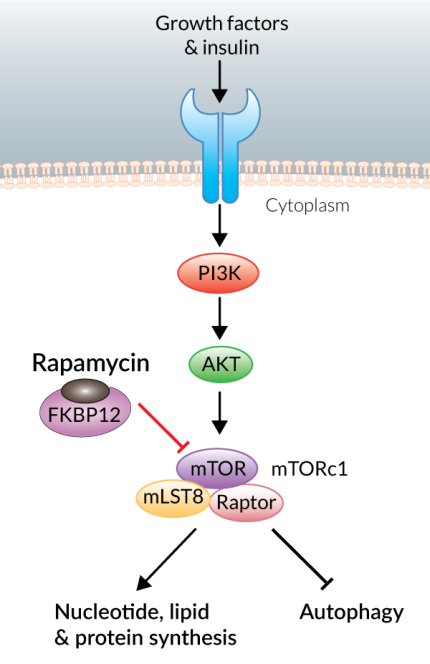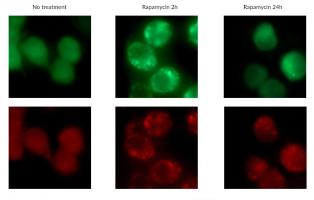Rapamycin
-
Cat.code:
tlrl-rap-2
- Documents
ABOUT
mTOR Inhibitor and Autophagy Inducer
Rapamycin is an inhibitor of the protein kinase mTOR (mammalian target of Rapamycin), which regulates cell growth and metabolism in response to environmental cues. mTOR is the catalytic subunit of the multi-component complex mTORc1. mTORc1 signaling inhibits autophagy while promoting cell growth by stimulating biosynthetic pathways, including the synthesis of nucleotides, lipids, and proteins.
Mode of action:
Rapamycin is an inducer of autophagy, as inhibition of mTOR mimics cellular starvation by blocking signals required for cell growth and proliferation [1]. Specifically, Rapamycin simultaneously binds to the intracellular 12-kDa FK506-binding protein (FKBP12) and to the FKBP12/rapamycin-binding (FRB) domain of mTOR. This results in direct inhibition of mTORc1 signaling.
While mTORc1 inhibition by Rapamycin is well established, its effect on mTORc2 is less well characterized. Previously, the mTORc2 complex was thought to be Rapamycin-insensitive. However, studies show that prolonged Rapamycin treatment inhibits the assembly and function of mTORc2 in some, but not all, cell lines or tissues [2, 3].
Key features:
- A potent mTOR inhibitor
- Blocks phosphorylation of mTORc1
- An autophagy inducer
![]() Read our review on Autophagy and Innate Immunity
Read our review on Autophagy and Innate Immunity
References:
1. Jung CH. et al., 2010. mTOR regulation of autophagy. FEBS Lett. 584(7):1287-95.
2. Sarbassov D.D. et al., 2006. Prolonged rapamycin treatment inhibits mTORC2 assembly and Akt/PKB. Mol Cell. 22:159–168.
3. Schreiber K.H. et al., 2015.Rapamycin-mediated mTORC2 inhibition is determined by the relative expression of FK506-binding proteins. Aging Cell.14(2):265-73.
All InvivoGen products are for research use only, and not for human or veterinary use.
SPECIFICATIONS
Specifications
mTOR
C51H79NO13
20 mM in DMSO
100 nM - 25 µM for cell culture assays (see references in TDS)
Negative (tested using EndotoxDetect™ assay)
Autophagy studies
CONTENTS
Contents
-
Product:Rapamycin
-
Cat code:tlrl-rap-2
-
Quantity:20 mg
Shipping & Storage
- Shipping method: Room temperature
- -20°C
- Avoid repeated freeze-thaw cycles
Storage:
Caution:
Details
Inhibition of mTOR activation
The mammalian target of Rapamycin (mTOR) is a protein kinase in the PI3K-related kinase family. It plays a crucial role in several cellular processes, including proliferation and survival [1]. This enzyme forms the catalytic subunit of two distinct protein complexes, known as mTOR complex 1 (mTORc1) and 2 (mTORc2).
Besides the mTOR catalytic subunit, mTORc1 consists of Raptor (regulatory associated protein of mTOR) and mLST8 (mammalian lethal with SEC13 protein 8). mTORc1 is Rapamycin-sensitive and plays a critical role in the regulation of cell growth, proliferation, survival, and motility. mTORC1 primarily controls protein synthesis through the direct phosphorylation of S6 Kinase 1 (S6K1) and 4E (eIF4E)-binding protein 1 (4E-BP1). In addition to regulating protein synthesis, mTORc1 activates lipogenesis and negatively regulates autophagy. Specifically, mTORc1 induces phosphorylation of autophagy-related 13 (ATG13) and the Unc-51-like autophagy activating kinase 1 (ULK1) which become unable to positively regulate autophagy.
The mTORc2 complex contains mLST8, Rictor (rapamycin-insensitive companion of mammalian target of rapamycin), and mSin1 (mammalian stress-activated protein kinase (SAPK)-interacting protein 1) [2]. This mTOR complex was originally thought to be Rapamycin-insensitive. However, studies show that prolonged Rapamycin treatment inhibits the assembly and function of mTORc2 in some, but not all, cell lines or tissues [3, 4]. mTORc2 activates several kinases, including Akt, SGK1, and PKC-α which regulate glucose and lipid metabolism and a variety of cellular responses. It has been suggested that the relative expression of FKBP12 and FKBP51, another intracellular receptor, may determine a cell or tissue's ability to respond to Rapamycin [5]. This mTOR complex negatively regulates autophagy through the phosphorylation of Beclin-1, GFAP, and VDAC1 preventing them from activating autophagy.
1. Sabatini D.M., 2017. Twenty-five years of mTOR: Uncovering the link from nutrients to growth. PNAS 114(45):11818-11825.
2. Ballesteros-Álvarez J. & Andersen J.K., 2021. mTORC2: The other mTOR in autophagy regulation. Aging Cell. 20(8):e13431.
3. Sarbassov D.D. et al., 2006. Prolonged rapamycin treatment inhibits mTORC2 assembly and Akt/PKB. Mol Cell. 22:159–168.
4. Schreiber K.H. et al., 2015.Rapamycin-mediated mTORC2 inhibition is determined by the relative expression of FK506-binding proteins. Aging Cell.14(2):265-73.
DOCUMENTS
Documents
Technical Data Sheet
Safety Data Sheet
Certificate of analysis
Need a CoA ?





